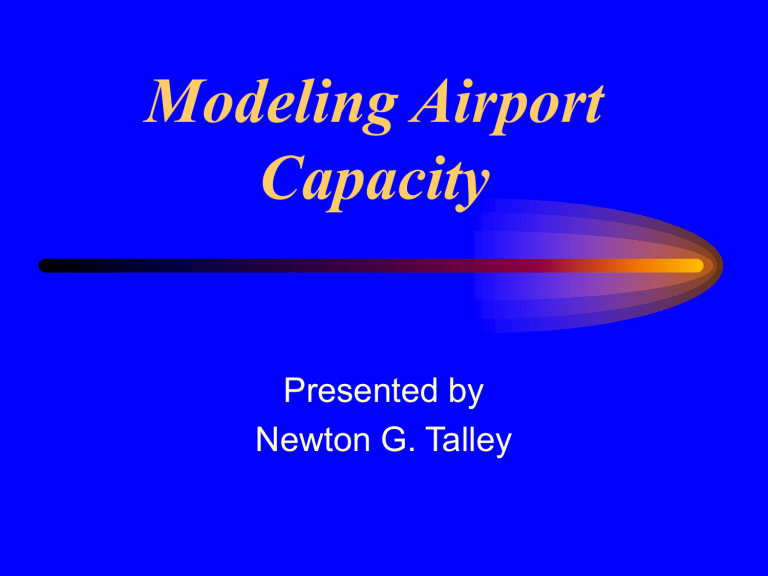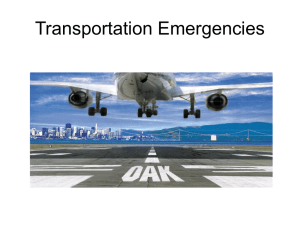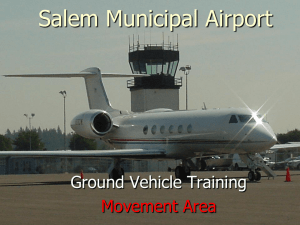Airport Capacity and Delay

Modeling Airport
Capacity
Presented by
Newton G. Talley
Overview
The FAA’s William J. Hughes Technical Center is the premiere aviation research, development, engineering, test and evaluation facility.
Within the center are Aviation R&D Programs, under which falls
NAS Engineering and Analysis
Airport and Airspace Capacity -- This section has been intimately involved in the FAA’s airport capacity program since 1976, beginning with a prototype study of Chicago O'Hare using and validating the Airfield Delay Simulation Model (ADSIM).
Graphical display for ADSIM is currently under development.
Overview (cont.)
Twelve initial studies were accomplished, then further studies were delayed by the controllers strike in 1981.
During that time the Runway Delay Simulation Model (RDSIM) was developed and the study of the top 40 delayed airports resumed in 1985.
The Airport and Airspace Simulation Model (SIMMOD) was procured for airspace studies in 1987.
Overview (cont.)
Recognizing the problems posed by congestion and delay within the National Airspace System, the FAA, airport operators, and aviation industry groups have initiated joint Airport Capacity
Design Teams at various major air carrier airports throughout the
U.S.
Each Capacity Design Team identifies and evaluates alternative means to enhance existing airport capacity, to handle future demand, to decrease delays, and to improve airport efficiency.
They also develop a coordinated action plan for reducing aircraft delay.
Airport Capacity Design Teams
I Typical design teams consist of representatives from the FAA,
Military, Airport Consultants, Airline representatives, ATA, Airport operators, ALPA, AOPA, and other concerned organizations
I Recommendations deal with airfield, facilities and equipment, and operational improvements
Airport Capacity Design Teams (cont.)
I Over 48 Airport Capacity Design Teams have either completed studies or have work in progress since inception of the program
I A typical Capacity Design Team makes twenty or more recommendations for capacity improvements at specific airports
I Capacity Design Team improvement recommendations become part of the airport master plan and are implemented when needed to meet demand
Airport Capacity Design Team Flow
Simulation Models
The FAA has procured and developed different computer models for airport analysis which are used to determine the capacity and delay of airports and to study the sensitivity of capacity and delay to various airport conditions. The results include:
I Hourly runway, taxiway, and gate capacity
I Hourly and daily delays, travel times, flow rates, and queuing data
I Annual delay and annual delay costs
I Annual delay savings computed from annual delay costs
Simulation Models (cont.)
The models fall into two categories:
I Analytic models - a series of equations which compute hourly capacity, daily delay, and annual delay from fixed input parameters
I Simulation models - fast time, critical event, random order or event-step models that emulate the movement of aircraft using special sampling techniques
Simulation Models (cont.)
The different models include:
I Runway Capacity Model
I The Runway Delay Simulation Model (RDSIM)
I Airfield Delay Simulation Model (ADSIM)
I Airport and Airspace Delay Simulation Model (SIMMOD)
Model Usage
Runway Capacity Model
I An analytic model consisting of a series of equations to compute airport capacity
I Assumes an infinite queue of arrivals and departures, and provides a theoretical maximum throughput for the runways
I Capacity is computed by determining the minimum sustainable time between successive arrivals and by inverting this time to find the maximum number of arrivals per hour
Runway Capacity Model (cont.)
I The maximum number of departures which can be inserted between the arrivals is then calculated, to give the arrival-priority capacity
I The inputs to the model are the airfield's geometry and operating strategy
I Each execution consists of a geometry/strategy combination coupled with other variables such as aircraft mix, average runway occupancy times (ROTs), and average separations
Runway Capacity Model (cont.)
I The principal output of the model is the total capacity per hour for a specified arrival percentage
I The model prints out both arrival-priority and departure-priority capacity figures. In addition, the output includes messages containing operating strategies for reaching given percentages of arrivals
Runway Delay Simulation Model (RDSIM)
I Primarily developed to perform runway capacity/delay analysis
I Simulates runway operations and provides both capacity and delay information
I Critical event random order model employing special sampling techniques
I Capacity simulations are made by varying the demand to compute capacity at an acceptable level of delay and maximum throughput
RDSIM (cont.)
I Results are calculated for a single traffic hour using many replications
I Capable of operating with arrival-priority, departure-priority, or balanced arrivals and departures
I Can be used to compute capacity at an acceptable level of delay and maximum throughput
I Delay simulations utilize daily demand to provide by runway, hourly and daily delay, flow rates and queuing data for arrivals and departures
RDSIM (cont.)
I Inputs include runway usage, runway occupancy times, exit probabilities, aircraft demand and mix, aircraft approach velocities, aircraft separations and ATC rules and procedures
I Runway delay statistics are similar to those produced by ADSIM
I Can readily be used to capture the main benefits of a given improvement, also to compare savings of various improvements
Review of past Design Team problems indicates that at least 95 percent of airport delays are runway-related and at least twothirds of the airport improvements studied are runway-related.
Airfield Delay Simulation Model (ADSIM)
I One of the most detailed models available for evaluating the operations and sources of delay on the airport's surface using a demand profile that contains meticulous definitions of the characteristics of the airfield surface, ATC procedures, and aircraft utilizing the airport
I Models the movement of aircraft throughout the airport system, producing estimates of delays (pinpointing sources) and hourly flow rates
ADSIM (cont.)
I Inputs include aircraft routings developed from a link-node diagram of the airport, runway and taxiway usage, runway occupancy times and exit probabilities, aircraft approach and taxiing velocities, aircraft separations, gate service times, aircraft demand and mix, and ATC rules and procedures
I Outputs are hourly arrival and departure flow rates, travel times, arrival and departure delays for each runway, total delays for each link on the airfield, departure queue lengths, and individual aircraft delays
Airport and Airspace Delay
Simulation Model (SIMMOD)
I Address delays, capacity, and fuel consumption resulting from changes in airspace utilization and operational procedures beyond an airport's immediate airspace
I An event-step simulation model which traces the movement of individual aircraft and simulated ATC actions required to ensure aircraft operate within procedural rules
I Computes the impact on aircraft delay and fuel consumption using a wide variety of parameters
SIMMOD (cont.)
I Inputs include traffic demand and fleet mix, route structures, runway use configurations, separation rules and control procedures, aircraft performance characteristics, airspace sectorization, interactions among multiple airports, and weather conditions
I Input parameters include: permissible airborne speed ranges for use by ATC, runway occupancy times, safety separations, landing roll and declaration characteristics, taxi speeds, and runway/taxiway utilization
SIMMOD (cont.)
I Users control the timing of the simulation and the desired output reports and provide data regarding the occurrence of various simulation events
I Output consists of reports providing statistics describing aircraft delay, travel time, and fuel consumption
I A post-processing animation system shows the movement of aircraft on the airfield and in the airspace
Program Requirements Continue
I Twenty-five airports each exceeded 20,000 hours of airline flight delays in 1995
I The number of airports exceeding 20,000 hours of annual airline flight delays is projected to grow from 25 to 29 by 2004 if no capacity improvements are made
I The challenge for the air transportation industry is to enhance existing airport and airspace capacity and to develop new facilities to handle future demand
I Greater emphasis has been put on the redevelopment and expansion of existing airport facilities as environmental, financial, and other constraints continue to restrict the development of new airport facilities in the U.S.
Information Source
The preceding information may be accessed by going to
The FAA's
William J. Hughes Technical
Center Homepage at http://www.tc.faa.gov/act500/capacity/index.htm







